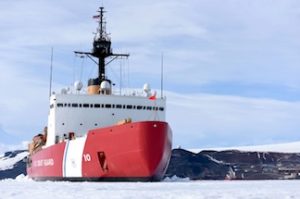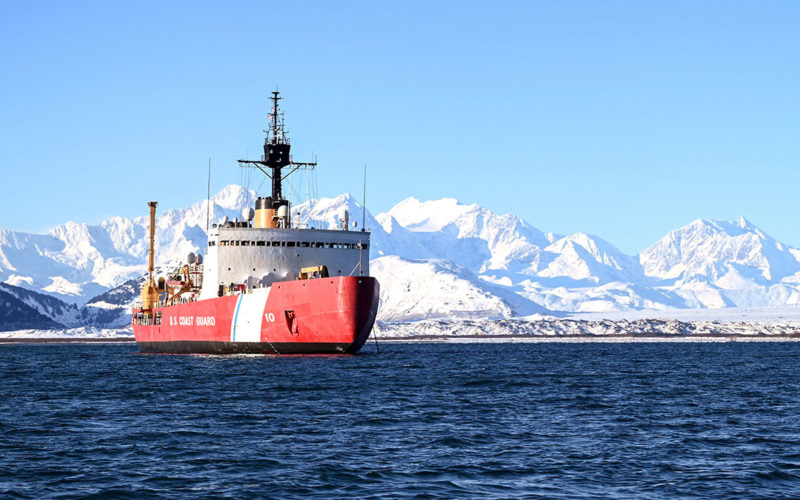
Despite “absolutely treacherous” conditions, the recent Arctic mission by the U.S. Coast Guard cutter Polar Star — the nation’s only heavy icebreaker — has been deemed a major success by the vessel’s commanding officer.
“I’m incredibly proud of this crew,” Capt. William Woityra told Professional Mariner in March.
Polar Star left Seattle in early December after quarantining and double rounds of COVID-19 testing. The icebreaker then made its way through the Bering Strait, Chukchi Sea and Arctic Ocean to 72 degrees north, farther than any U.S. surface ship had ever gone in winter, before returning Feb. 20.
Everything about this trip was a departure from normal for the 45-year-old cutter, which was on schedule last fall to head to Antarctica for an eighth straight year to clear ice for cargo ships and tankers to resupply McMurdo Station, a National Science Foundation research facility. But fearing the introduction of COVID onto a continent with no advanced medical care, the NSF canceled the resupply mission in October, saying it could get by with a skeleton crew and occasional airdrops.
“We seized the opportunity to deploy into the Arctic instead,” said Woityra, whose first voyage as an ensign 22 years ago was aboard Polar Star. After various global assignments and managing the nation’s icebreaking policy, he returned to the ship in 2019 and was named captain in 2020.
“This was pretty exciting. Instead of going south to the penguins, we were going to the northern lights and polar bears, to an area where there’s a lot going on environmentally and geopolitically,” he said.
Woityra said he and his 134-member crew welcomed the change but had no way of knowing how many tough circumstances they’d confront. For starters, 24-hour darkness was challenging, both for morale and operations.
“Even with floodlights and searchlights, we could only see out a couple of hundred yards,” he said. “It was like driving a car down the highway but not being able to see past your hood ornament.”
The ice was “by far the toughest I’ve ever experienced, owing largely to really low temperatures,” Woityra said. “We had entire weeks that never went above zero (Fahrenheit) and routinely saw hurricane-force winds in excess of 65 knots. When wind starts pushing on a sheet of ice, ice starts moving and the ship goes with it.”
Noise produced by that shifting along the hull was sometimes nearly unbearable. “It made an awful sound, screeching and high-pitched, and just cut right through your stomach,” he said. “The hull is almost 2 inches of steel so we knew we were safe, but man, it was really uncomfortable.”
Bringing fresh air into the ship was necessary to maintain proper ventilation, but snow built up in the engine rooms, pipes froze and burst, and oil got so cold it turned to gel. At one point the turbines couldn’t start, and engineers worked around the clock for a week to figure out how to pump hot air into the turbine enclosures to raise the temperature. “It was an extraordinary effort,” Woityra said.
Another whopping challenge was being COVID-confined for 78 days with no shore leave. “This was very hard. It’s a testament to this crew that they were able to persevere. Their resilience through this entire year has been astounding,” Woityra said.
Despite the adversity, the captain said the crew impressively carried out its mission: to defend U.S. sovereignty and conduct training and scientific experiments.
After the U.S. fishing fleet in the Bering Sea was harassed by the Russian military last summer, “one of our goals was to project U.S. power in the Arctic in a responsible manner, to model good, positive maritime behavior,” Woityra said. “We were there on standby for search and rescue or marine environmental response, but also to remind the world that the United States is an Arctic nation, that we have Arctic territory and sea that we not only have responsibility for but also have rights to.”
In addition to the geopolitical aspects of the mission, 10 new ice pilots got qualified and a variety of other mariners were aboard to become “the proficient ones training new folks coming up,” from members of the United Kingdom’s Royal Navy to U.S. Merchant Marine Academy cadets.
To assist scientists eager to better understand the Arctic, the Coast Guard deployed depth sensors for the Woods Hole Oceanographic Institution and ice buoys to help the University of Washington track ice flow; determined how well a new satellite communications system operated in high latitudes and extreme cold for the Defense Department; and conducted experiments for the Marine Board of Investigation looking into the fatal sinking of the crab boat Scandies Rose near Sutwik Island, Alaska, in 2019.
Polar Star will get $75 million in upgrades over the next five years to keep it operational through 2029 or 2030, when the second of three polar security cutters is expected to be ready. Halter Marine of Pascagoula, Miss., is building the new class of 460-foot heavy icebreakers.
“The Arctic is getting a lot more attention, so our investment in polar security cutters is coming at the right time,” Woityra said.
More immediately, the captain is preparing for another Polar Star mission in November to McMurdo, which soon will undergo its own modernization.

